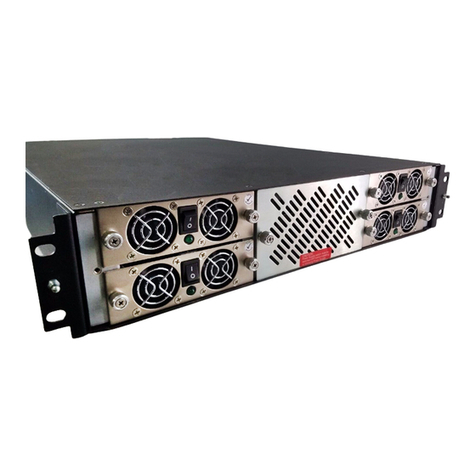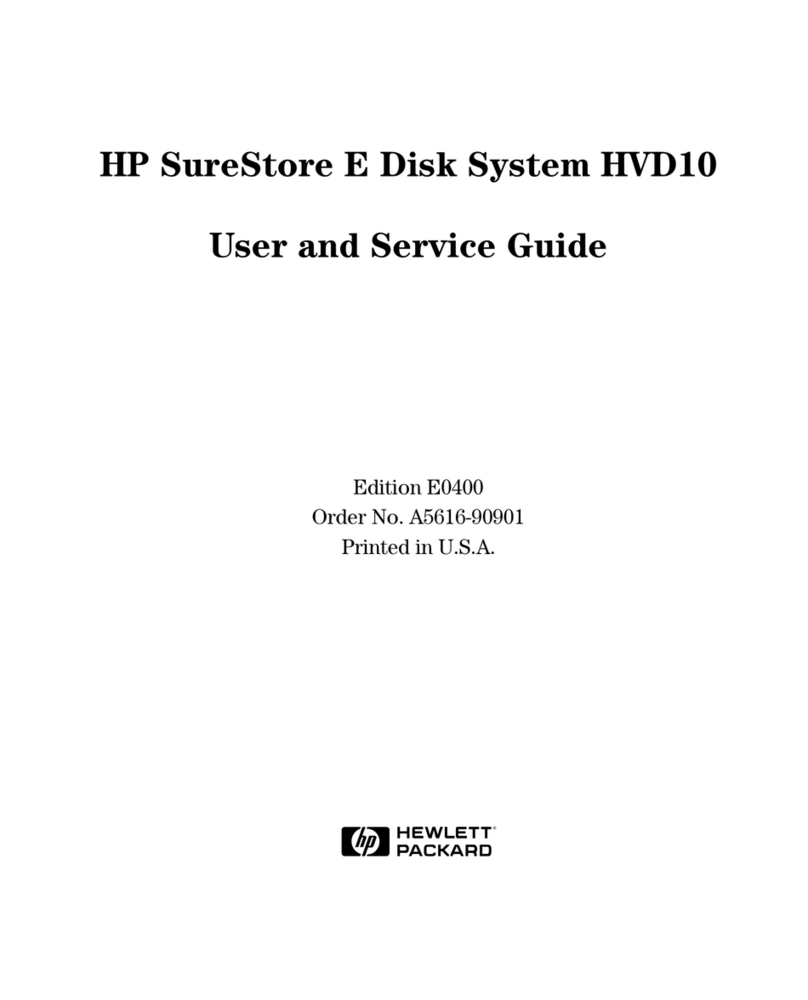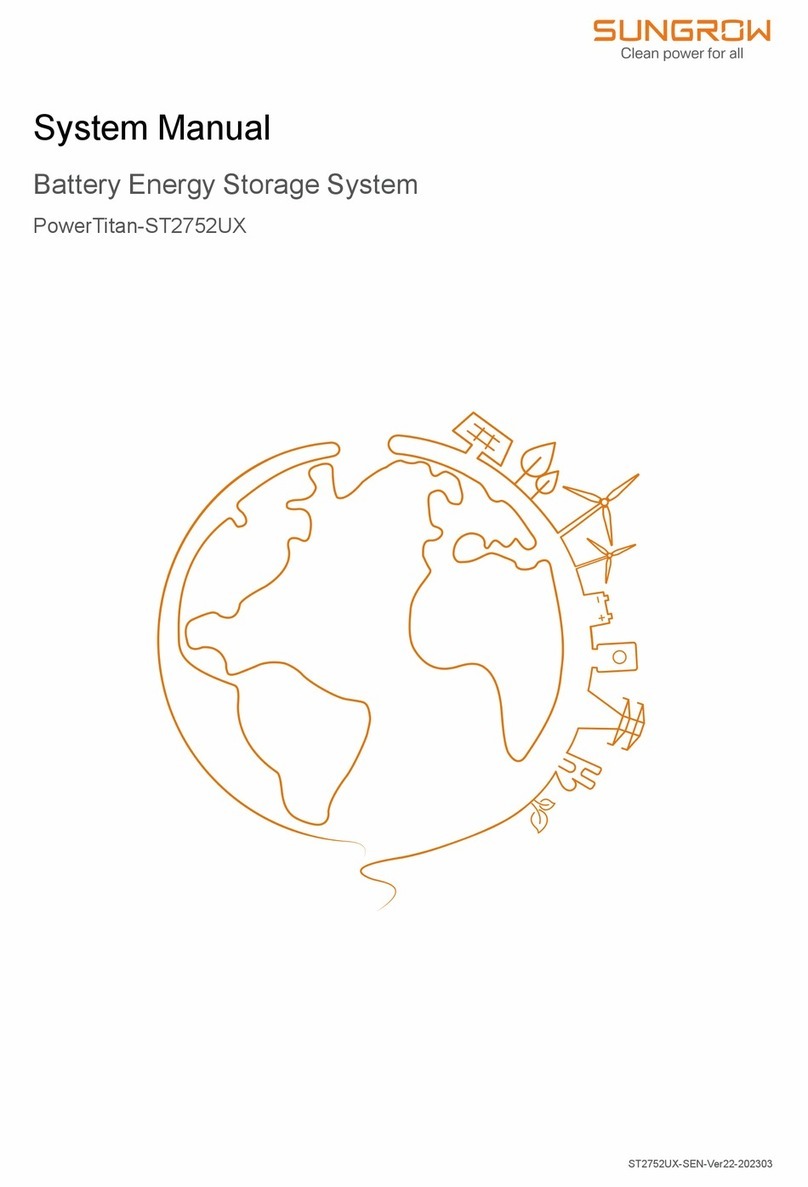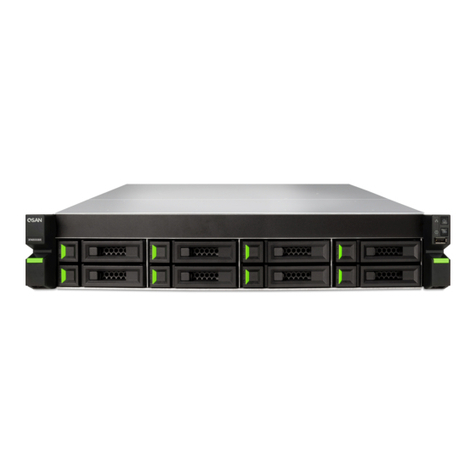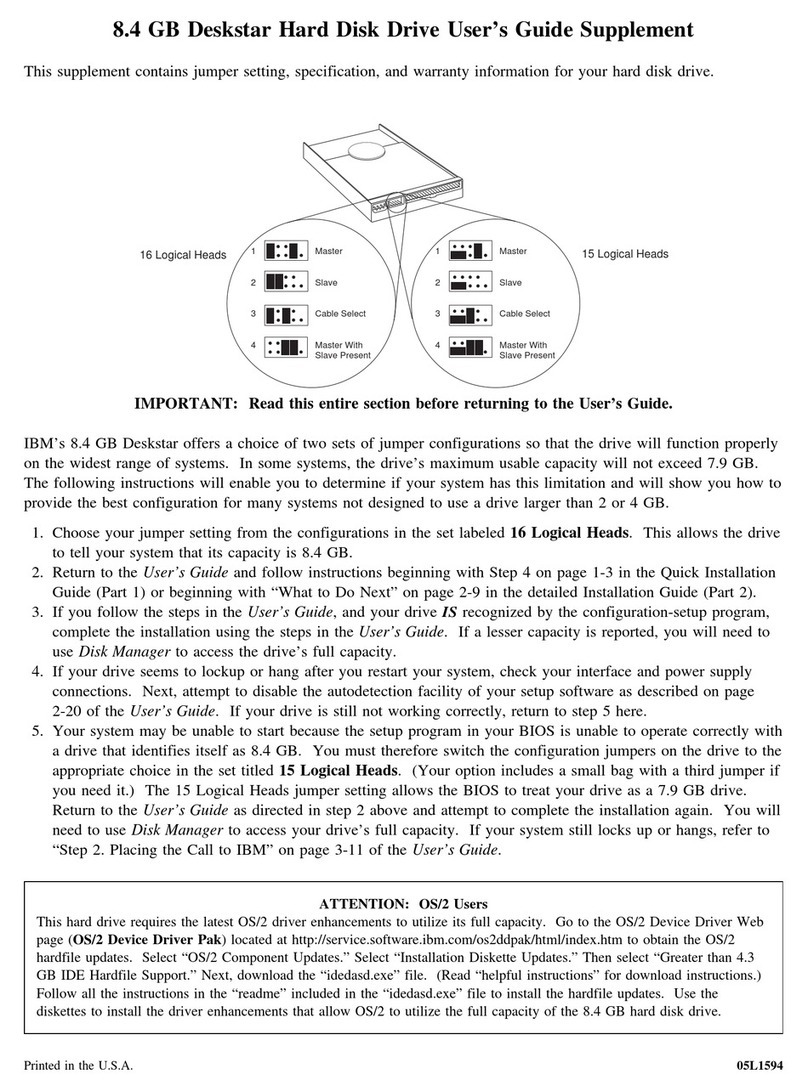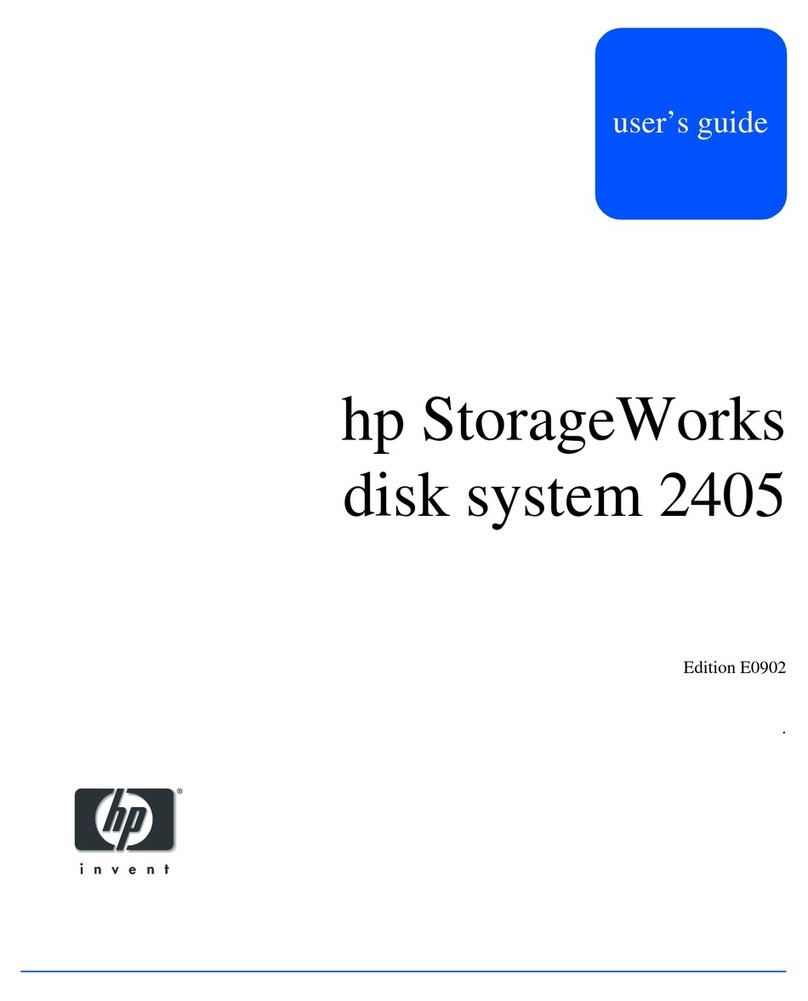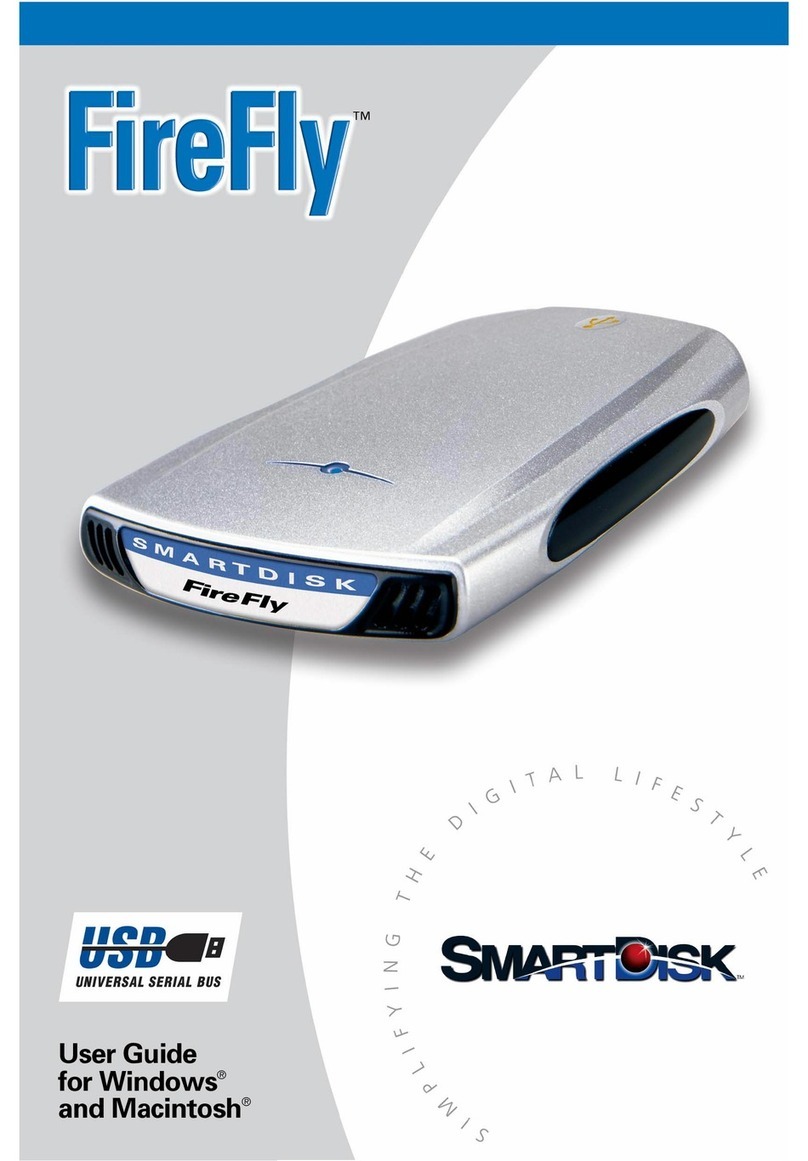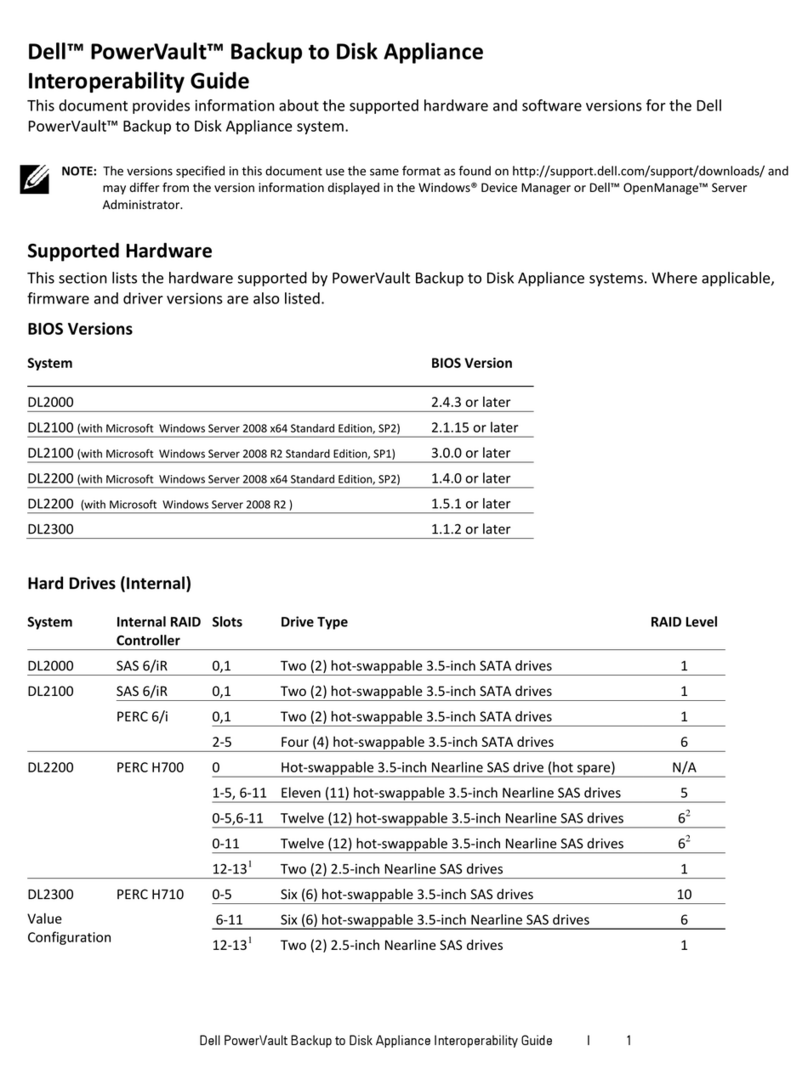Eguana Evolve ESS AU-13 kWh User manual

Models
Evolve ESS AU -13 kWh / -26 kWh / -39 kWh
Evolve LFP AU -14 kWh / -28 kWh / -42 kWh
Evolve 0513
Owner’s Manual

IMPORTANT INSTRUCTIONS
This manual contains important product information for your Evolve battery energy storage system (BESS). This
document is accurate at the time of publishing. Eguana reserves the right to make updates to the product
without notice. For the latest Evolve documents, please visit our website at www.eguanatech.com
WARNING! Read this document in its entirety before using this product. Failure to follow instructions or
warnings can result in electrical shock, serious injury, or death. Operating the product in a way that it was not
intended can also result in permanent damage to the product.
This manual applies to the following energy storage systems:
Evolve ESS AU -13 kWh / -26kWh / -39kWh
Evolve LFP AU -14 kWh / -28 kWh / -42kWh
Evolve 0513
Warranty
The Eguana Evolve includes a 10 year standard warranty with performance pro-rating for the battery modules.
Please review the warranty statement included with your product.
IMPORTANT! An internet connection is required in order to make warranty claims for defective battery
modules. The Evolve system supports wired and/or wi-fi internet connection options. Please consult your
installer regarding your preferred internet connection method.

Table of Contents
Contents
1 SAFETY..................................................................................................................................................................................1
1.1 IN CASE OF EMERGENCY......................................................................................................................................1
1.2 GENERAL SAFETY PRECAUTIONS..........................................................................................................................2
1.3 ENVIRONMENTAL PROTECTION.............................................................................................................................2
2 INTRODUCTION ...................................................................................................................................................................3
2.1 OVERVIEW..........................................................................................................................................................3
2.2 SYSTEM MONITORING –ACCOUNT SETUP............................................................................................................4
3 OPERATION ..........................................................................................................................................................................4
3.1 LED DISPLAY INDICATORS ..................................................................................................................................4
3.2 SERVICE BUTTON ...............................................................................................................................................5
5 BACKUP POWER OPERATION ........................................................................................................................................5
5.1 BACKUP POWER DISPLAY MODES.........................................................................................................................5
5.2 RESTARTING THE BATTERY SYSTEM AFTER LOW BATTERY SHUTDOWN ...................................................................6
5.3 MANUALLY SETTING THE BATTERY MINIMUM SOC RESERVE ..................................................................................7
6 MAINTENANCE....................................................................................................................................................................8
7 TROUBLESHOOTING .........................................................................................................................................................8
8 INSTALLER CHECKLIST .....................................................................................................................................................9

1
1 Safety
Throughout this manual, the following symbols will be used to highlight important information and procedures:
Symbol
Definition
WARNING! A dangerous voltage or other condition exists. Use extreme caution when performing
these tasks.
CAUTION! This information is critical to the safe installation and or operation of the system.
Follow these instructions closely.
NOTE: This statement is important. Follow instructions closely.
1.1 In case of emergency
In all cases:
If safe to do so, switch off the AC breakers (external to the system) for the system.
Contact the fire department or other required emergency response team.
Evacuate the area, and if applicable, follow your emergency evacuation plan if others are in proximity to the
installed location.
In case of fire:
When safe, use a fire extinguisher suitable for use; including A, B, and C dry chemical fire extinguishers or carbon
dioxide extinguishers. Do not use type D extinguishers.
In case of flooding:
Stay out of water if any part of the system or wiring is submerged.
Do not attempt to operate batteries that have been submerged in water even after they have been dried.
In case of unusual noise, smell or smoke:
If safe to do so, ventilate the area.
In case of weather alerts including tornado, hurricane or potentially wind-damaging risk:
The system is capable of automatically generating emergency backup power on loss of grid, however, in the case
where winds are potentially threatening to your building structure and safety, it is recommended to shut down
your system in advance of, and for the duration of, the extreme weather event, and to return to operation only
after it appears safe to do so.

2
1.2 General safety precautions
Important! Never operate the system in a manner not described by this manual.
Only qualified personnel should service this product.
Risks of Fire
Do not expose the system to temperatures exceeding 45 degrees Celsius.
Avoid installation in direct sunlight.
Do not store objects on top of the cabinet.
Do not obstruct the intake or exhaust of the forced airflow system.
Do not store combustible objects and corrosive chemicals directly adjacent to the system.
Risks of Shock
WARNING! Hazardous Voltages. The Inverter contains hazardous voltage and energy that may be lethal.
It may only be installed by qualified personnel who have read this manual and are familiar with its operation and
hazards.
Only connect the PCS cabinet to a compatible electrical service as defined in the model specifications. The PCS must be
connected to a dedicated branch circuit in the main electrical panel.
Ensure proper electrical grounding in accordance with code requirements.
CAUTION! Both AC and DC voltage sources are terminated inside this equipment. Each circuit must be
disconnected before servicing.
Risks of Damage
The PCS is compatible with the LG Chem battery model EM048126P3S7 only. Do not attempt to connect any other
battery to the system.
Do not connect any other loads directly to the battery power bus.
Do not drop, tip, or puncture the cabinet during transport and installation. Visible damage to the cabinet and/or internal
components should be reported to the manufacturer immediately.
Do not store this system for periods longer than six months without a battery maintenance charge. This may result in
permanent damage to the batteries.
Do not operate the system outside the operating temperature range (-10 to 45C)
1.3 Environmental protection
Do not dispose of the system or any of the components within the cabinet. Batteries, electronics, cables,
and metal parts are recyclable. Consult your municipal waste management authority to determine
required methods of component recycling.

3
2 INTRODUCTION
2.1 Overview
This manual contains instructions for the operation of the Eguana Evolve™home energy storage system. This
product, when installed, is permanently wired to the home electrical panel.
There are two main components as shown below, including the energy storage system (1), and the energy
meters installed in the main electrical panel (2). The system may include one or two meters, depending on the
solar system that is installed.
This product is intended to operate in parallel with a utility connected solar PV system, and is designed to
manage the consumption of utility and solar energy within the home. The system is capable of providing limited
backup power to the home in case of a grid outage, as well as charge batteries from the solar system. A sample
diagram below shows a typical layout of an AC coupled solar plus storage system.
Your system may be installed in a manner
differently than shown above. In addition, in
accordance with your local electrical code, your
installer may have included dedicated emergency
disconnect switches for your battery and solar
systems. Consult your system installer regarding
the application and installation setup of your
specific system. Refer to the Installer Checklist at
the end of this document regarding information to
be provided to you from your certified system
installer.
The backup electrical panel shown is a dedicated electrical bus separated from the main electrical bus. While
they are shown as two independent panels above, the backup panel may be co-located inside the main
switchboard.
1
2
Air inlet
Air exhaust
Display
Panel
mounted
energy meter
Solar
Inverter
Solar
panels
Evolve
Battery
System
Main
Electrical
Panel
Backup
Electrical
Panel
Home
Internet
Service
M
M

4
2.2 System Monitoring –Account Setup
To view your system online, download the Stormcloud by SwitchDin app (available in IOS
& Android) and enter the login credentials provided in the account invitation email issued
by your installer. Alternatively, access the monitoring system via web-browser @
https://pwa.switchdin.com/account/login
3 Operation
The Evolve home energy storage system is fully automated. The EMS will be programmed
to connect the system to the grid after AC and DC sources are applied. While the
monitoring system provides a complete dashboard of your system’s operating state, the
LED display on the front of the battery system can be used to determine its present
operating conditions.
3.1 LED Display Indicators
The display panel provides indication of the following:
Battery status (state of charge)
System operating mode
(out of) Service Indicator
To conserve energy, the LEDs will turn off after 5 minutes from
being activated. They can be re-activated by pressing the
service button.
LED
Mode
Definition
State of charge. Each LED represents 20%
SOC. Solid = battery idle.
Charge = flash right. Discharge = flash left.
Low battery.
Sleep / Standby mode.
Grid timing mode.
Grid synchronization mode. Ten second test
before grid connect mode.
Grid connected mode.
System OK.
System out of service.
User initiated service mode.
Battery SOC
Service button
PCS Operating Mode
Service Mode
Blink
Flash
Solid

5
3.2 Service Button
The service button can be used to wake the LED display, and either put the system into or out of service mode, as
well as cycle through various operating modes.
IMPORTANT! In the event that the system has gone out of service, please consult your installer for
guidance. Depending on the nature of the service fault, your installer may advise you to reset the system
on your own, or schedule a service visit.
5 Backup Power Operation
This system will provide backup power to dedicated electrical circuits within the home via a permanently wired
electrical sub-panel, referred to as the backup panel. Backup power is limited in rating and duration, both of
which are dependent on the nature of the loads connected to the system, and the availability of the solar PV
supply. This system is designed to reliably provide power to a refrigerator, lighting, and small appliances.
NOTE: This product is not an uninterrupted power source (UPS). Following a utility outage, a four second
power interruption will occur before the backup power source commences. A portable UPS is
recommended for devices that require uninterrupted power.
IMPORTANT! Surge rated loads, ie) power tools, portable air conditioners, etc, may cause an overload
shutdown. Equipment of this type that is connected to the backup panel should be inspected and tested
regularly as per manufacturer suggested schedules. Permanent damage to the battery system and/or your
equipment may occur if exposed to chronic overloading cycles. The power output / surge rating will be further
limited when the battery is below 10% SOC.
IMPORTANT! Do not attempt to connect a gas generator to the battery system. If generator support is
required, consult your installer regarding a separate manual transfer to your backup electrical panel.
5.1 Backup power display modes
Display
Definition
Battery status LEDs indicate the following:
•Charge = flash right. Discharge = flash left.
•PCS and service lights off.
Low SOC shutdown in backup mode. See section 5.2 to restart the system.
Low SOC shutdown initiated while out of service. See troubleshooting –section 7, “service light
on in backup mode”.
Observed state
Action
Service button command
Service light on
Exit service mode
Press and hold 5 seconds

6
5.2 Restarting the battery system after low battery shutdown
The system will shutdown when the battery reaches a critically low level during backup operation. To restart the
system:
IMPORTANT! Direct sunlight is required to charge the battery. If
the battery system is installed without PV connected to the backup
panel, do not attempt the restart. Wait for the utility power to return.
1. To increase the battery charge rate and/or prevent further discharge,
shut off all home circuits in the electrical switchboard. The battery and
solar PV circuits must be ON.
2. Press and hold the service button
for 5 seconds.
3. The battery system will restart. The battery will begin to charge
approximately one minute after the PV system is energized. If the battery
does not begin to charge within 15 minutes of restart, it will shut down
again.
4. Where home circuits have been
shut OFF in step 1 above, allow
the battery to charge to 10%,
then turn ON the home circuits.
The charge time is dependent on
the amount of solar production.

7
5.3 Manually setting the battery minimum SOC reserve
The default minimum SOC reserve is set to optimize the system’s operation in a solar self-consumption mode. In
the case of a scheduled grid outage, or a weather event which risks a grid outage, the battery minimum reserve
can be manually set to its maximum value to maintain a full battery. Once the event and/or event risk has passed,
the setting must be manually returned to the lowest value to return to solar self-consumption mode.
Login to the SwitchDin Stormcloud app and follow the steps below to change the minimum SOC reserve.
Note: Settings changes require the battery system to be connected to the internet, and battery health = OK as
shown in the health block within the Overview menu (see image below –step 2).
My Battery
My Battery
My Battery
My Battery
1
2
3
4
5
1. Select ‘My Battery’
(your battery unit’s name).
2. Select Equipment in the bottom menu.
3. Select Devices (below Endpoint
attributes).
4. Select EguanaPcs.
5. In the Settings window, enter the new
SOC limit and select [Update].
Note: Max = 90
Note: Return the SOC limit to the Min
value after the outage event and/or event
risk has passed.

8
6Maintenance
The Evolve home energy storage system is a maintenance free product. Regularly scheduled inspection of the
airflow path for the active cooling fans on the bottom side of the PCS cabinet is all that is required. This
inspection should occur on annually.
If the fan ventilation holes are obstructed with dust / debris, a soft-bristled brush can be used to wipe them clean.
For heavy soiling use a soft, dry brush. Do not use any solvents, scouring, or corrosive materials to clean the unit.
Never remove or unplug connections or plugs during cleaning.
7Troubleshooting
System faults are reported and logged in the monitoring system. All fault logs are also accessible remotely by
your installer. Contact your system installer as recommended below if any of the following conditions are present
on the front display of the inverter panel.
PCS indicator status
Definition
Service light ON in grid mode
System is prevented from normal operation due to internal fault. Notify service personnel.
Service light ON in backup
mode
Possible overload condition which prevents the system from operating safely. If the
battery SOC is greater than 20% (one or more Green battery status LEDs), reduce the load
by shutting off circuits in the backup electrical panel, then press and hold the service
button 5 seconds to resume backup power operation. If the battery SOC is less than 20%
(SOC Led is yellow), do not attempt to resume backup operation until sunlight is present
to provide a solar charge of the battery.
All panel lights flashing
System is attempting to communicate with the battery modules. Notify your service
provider if this condition persists more than 30 minutes.
All panel lights OFF after
service button wake
command
This indicates loss of both AC And DC sources to the PCS. Notify your service provider.
Online monitoring system not
accessible
Check the internet connection. If connection is via wi-fi, reboot wireless router, and make
sure login user and password have not been changed since time of original installation.
Check power to the Evolve energy management system via the orange indicator light on
the right side of the panel. Note: the energy management system may lose power after
an extended grid outage where there is not enough solar generation to maintain battery
system power. Note: monitoring system servers may occasionally be down for service. If
first attempts are not successfully, try again the following day before contacting your
service provider.

9
8 Installer Checklist
Following the completion of your energy storage system installation, ensure your installer has provided you with
the following information for your personal records. Note that we may ask you for this information in the event
you need to make a warranty claim:
•Record of purchase, including date of installation, installer name and contact details.
•Copy of the electrical permit.
•Serial numbers for Battery System cabinets (PCS & Battery).
•EMS gateway UID –this is the unique identifier of your EMS gateway that connects to your internet
service.
Further to the information provided above, ask your installer to identify the following within your system
installation:
•Location of circuit breakers, and if applicable, installed emergency disconnect switches in case an
emergency shutdown of the equipment is required.
•Location of the backup electrical panel, including a list and identifier of each circuit within the panel.
•Record of all loads tested at the time of installation.
This manual suits for next models
6
Table of contents
Other Eguana Storage manuals
Popular Storage manuals by other brands
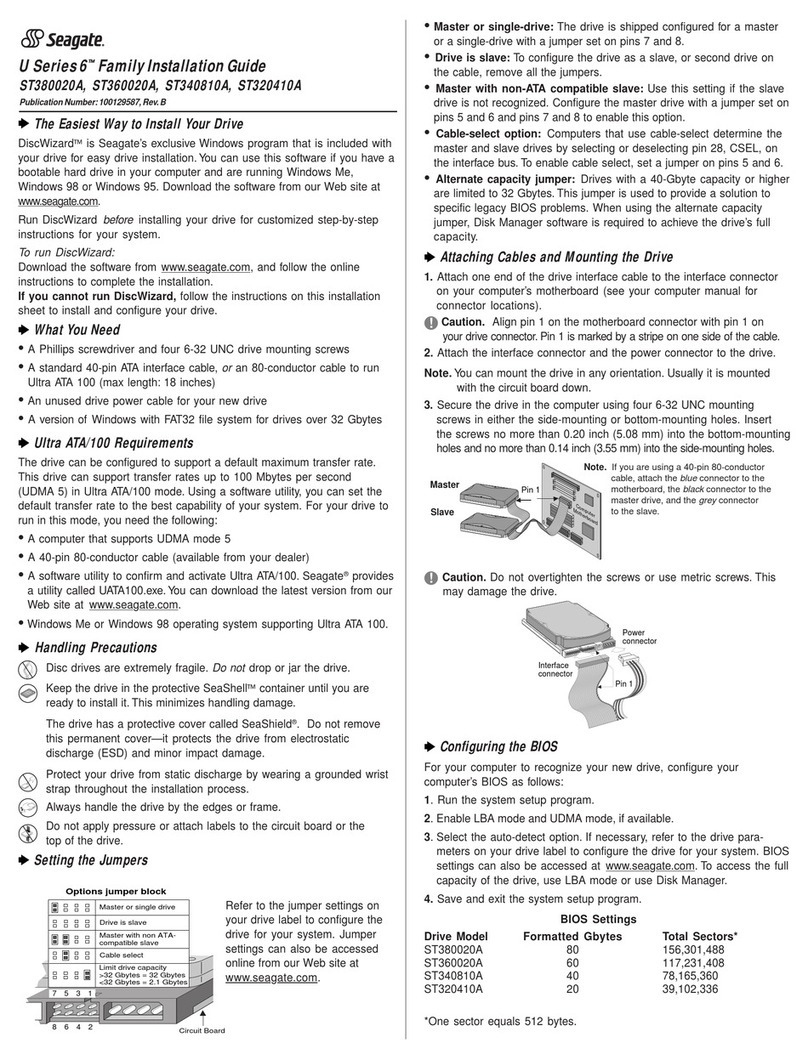
Seagate
Seagate ST380020A installation guide
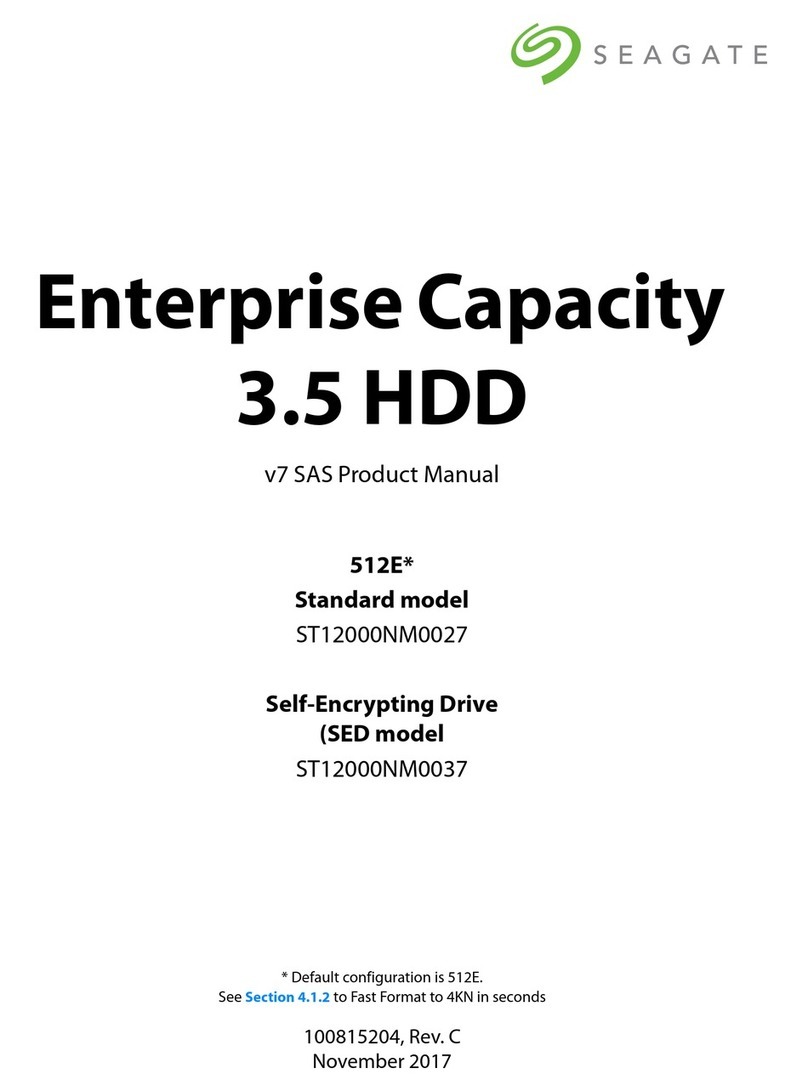
Seagate
Seagate ST12000NM0027 product manual

EMC
EMC Celerra NS20 Setting up

Overland Storage
Overland Storage SnapExpansion XSR quick start guide
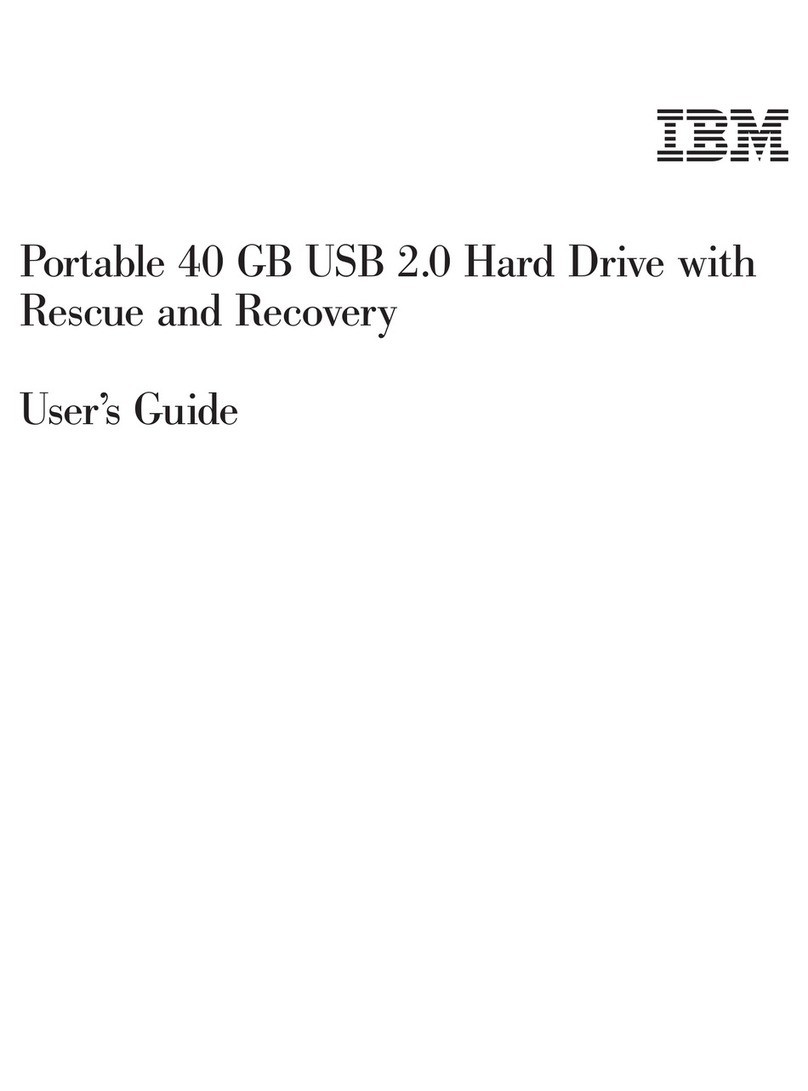
IBM
IBM 22P7196 - ThinkPlus Portable 40 GB External Hard... user guide

Fujitsu
Fujitsu Eternus DX80 S2 Configuration guide server connection



